Ruby certification matters because it verifies authenticity, origin, and treatment status of stones you’re evaluating. As a gem expert, you’ll need this documentation to distinguish natural rubies from synthetics, confirm geographic sources like Burma (which can increase value by 50-100%), and identify treatments that affect pricing. You’ll build client trust through transparent, verified information and protect yourself from potential misrepresentation claims. The right certification knowledge transforms how you’ll advise clients on their valuable investments.
Why Ruby Certification Matters For Gem Experts
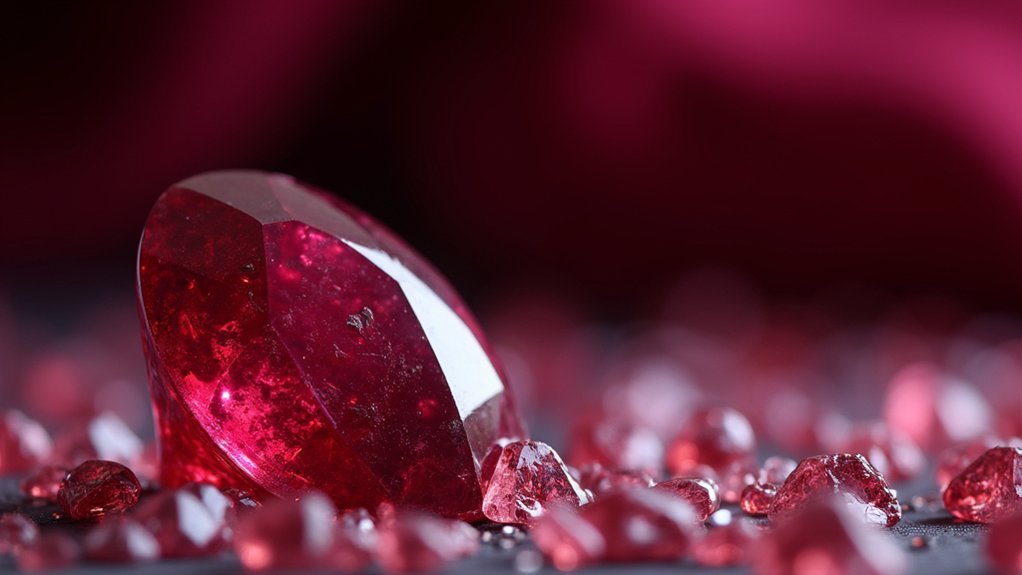
While many factors influence a ruby’s value, certification stands as the cornerstone of professional gemstone authentication. As a gem expert, you’ll rely on ruby certification to verify whether a stone is natural or synthetic—a distinction that dramatically affects market value.
Certified rubies provide essential information about treatments and origin. When you examine certification reports, you’ll know if a ruby is untreated or heat-treated, and whether it comes from highly prized sources like Burma. This provenance directly impacts desirability and price.
The standardized grading system detailed in certifications enables you to assess color, clarity, and cut with precision. By understanding these metrics, you’ll make informed recommendations to clients and guarantee transparent transactions, protecting everyone involved from misrepresentations in the gemstone market.
The Fundamentals of Ruby Certification Standards
Ruby certification operates on established standards that form the bedrock of professional gem evaluation.
You’ll need to understand the “Four Cs” – color, clarity, cut, and carat weight – which serve as primary assessment criteria in ruby certification standards.
The certification process relies on accredited gemological laboratories employing advanced technologies to accurately grade each stone.
When evaluating certified rubies, origin plays a key role, with Burmese specimens commanding premium prices due to their exceptional quality.
Treatment disclosures represent an essential component of certification, as untreated rubies are considerably more valuable than enhanced stones.
Prestigious institutions like GIA and IGI maintain rigorous standards, ensuring certified rubies meet exacting criteria.
Distinguishing Natural Rubies From Synthetic Alternatives
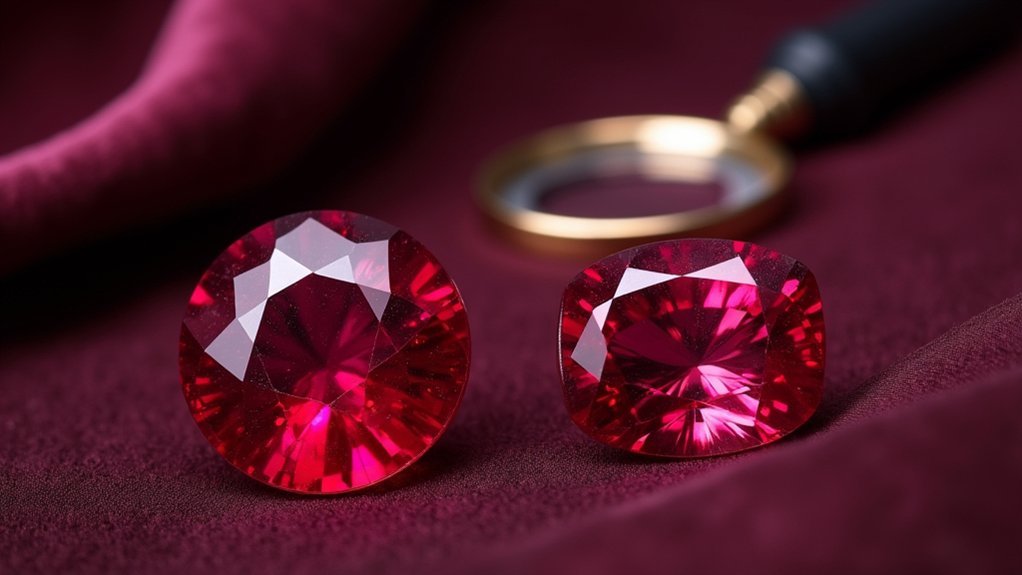
When you’re authenticating rubies, you’ll rely on sophisticated laboratory detection methods including spectrometry, microscopy, and X-ray diffraction analysis to reveal a stone’s true nature.
Natural rubies display distinctive inclusion patterns—often containing rutile needles forming “silk,” mineral crystals, and growth structures—that you won’t find in their synthetic counterparts.
You can quickly identify synthetics by looking for characteristic features such as gas bubbles, curved growth lines, and unnaturally perfect clarity, which serve as definitive markers in the certification process.
Laboratory Detection Methods
Although synthetic rubies have become increasingly sophisticated, modern gemological laboratories have developed robust techniques to distinguish them from their natural counterparts.
You’ll find that spectroscopy analysis reveals telling light absorption patterns that confirm a ruby’s authenticity, while Raman and photoluminescence testing expose the characteristic inclusions of natural rubies.
When you submit your gems for certification, experts will examine them for synthetic indicators like gas bubbles or curved striations.
They’ll also employ XRF and EDX technology to analyze chemical compositions and trace elements that differentiate natural from lab-created stones.
The GIA and other respected laboratories combine these laboratory detection methods to produce thorough reports that verify your ruby’s natural status and document any treatments.
This scientific approach guarantees you’ll receive accurate authentication for your valuable gems.
Telltale Identification Markers
Four distinct markers separate natural rubies from their synthetic counterparts when you’re seeking proper certification. As you analyze gem specimens, you’ll notice natural rubies display microscopic inclusions like rutile needles or “silk,” while synthetic rubies typically appear too clean.
Experienced gemologists in reputable gemological labs can identify these key differences during ruby certification processes.
- Color distribution – Natural rubies show complex, subtle variations, whereas synthetic rubies display uniform, often overly saturated coloration.
- Trace elements – Natural stones contain chromium with geographic indicators, while synthetics have higher iron and titanium levels.
- Heat treatment signs – Enhanced rubies reveal color zoning or gas bubbles, providing essential identification markers.
These telltale characteristics guarantee you’re making informed decisions when authenticating precious gemstones.
Color Grading Systems for Premium Ruby Specimens
The assessment of a ruby’s color represents the cornerstone of its valuation in the gemstone market.
When you’re certifying premium specimens, you’ll need to evaluate three critical components: hue, tone, and saturation. The coveted “pigeon blood” descriptor indicates exceptional vivid red coloration that commands top prices during certification.
Pigeon blood rubies represent the apex of gemstone certification, where perfect hue, tone and saturation meet in nature’s rarest masterpiece.
The GIA’s scale ranks rubies from “Faint” to “Intense,” with higher saturation grades directly correlating to increased market value.
You’ll find that color uniformity considerably impacts authenticity assessment; any zoning where color distribution varies detracts from the ruby’s overall grade.
Untreated rubies displaying pure red without secondary pink or purple hues represent the pinnacle of certification standards.
These natural specimens without color enhancements remain exceedingly rare, explaining why they fetch extraordinary prices from collectors and investors alike.
Detecting Treatment Methods in Modern Ruby Specimens
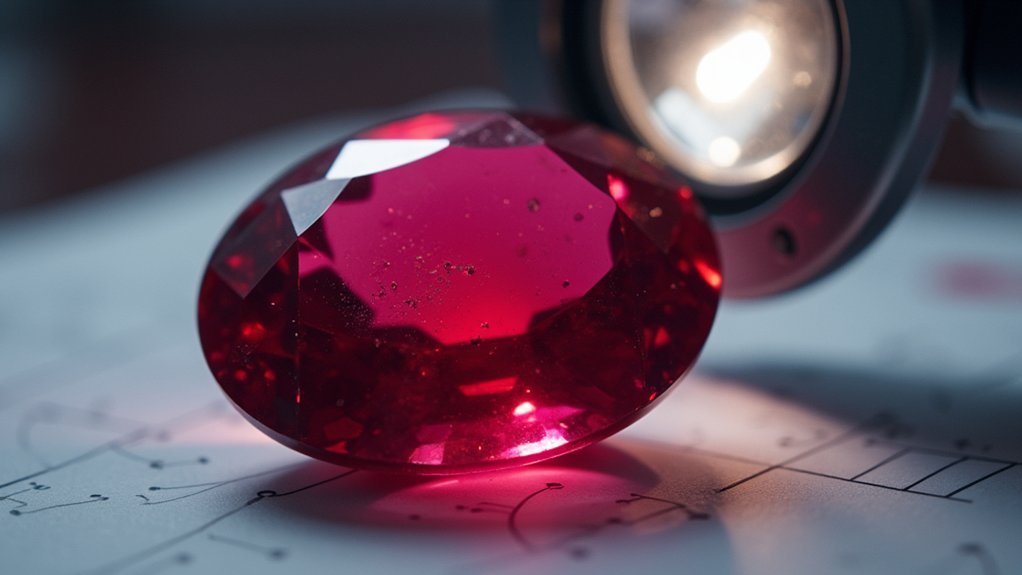
While color grading establishes a ruby’s visual merit, understanding treatment methods reveals its true nature and worth. As a gem expert, you’ll need ruby certification to identify whether specimens have undergone heat treatment or lead-glass filling—modifications that greatly impact both value and durability.
Advanced gemological techniques employed by certified labs uncover these interventions through spectroscopy and refractive index measurements.
- Look for specific inclusions like gas bubbles or glass-like materials that indicate treatments invisible to the naked eye.
- Remember that untreated stones command considerably higher market prices due to their natural rarity.
- Use certification reports to maintain transparency with clients and support informed investment decisions.
Without proper certification, you can’t accurately determine a ruby’s authenticity or advise clients on its true market value.
Geographic Origin Authentication for Value Assessment
When you’re evaluating a ruby’s market value, you’ll find that geographic origin often creates significant price premiums, with Burmese specimens commanding top dollar due to their legendary color saturation and fluorescence properties.
Modern gemological laboratories employ advanced spectroscopic techniques, chemical composition analysis, and inclusion studies to verify a ruby’s true geographic source with increasing accuracy.
Your understanding of these origin verification methods becomes essential when advising clients about investment-grade rubies, as even stones with identical visual characteristics can vary dramatically in price based solely on their authenticated place of origin.
Origin Premium Pricing
Five key regions dominate today’s ruby market, with Burmese stones sitting firmly at the price pinnacle.
You’ll find that ruby certification capturing origin details directly correlates with market value—a Mozambican ruby of identical color and clarity will typically command 20-30% less than its Burmese counterpart.
This geographic premium impacts investment decisions and resale potential.
When evaluating ruby investments, consider:
- Verification from reputable labs that specifically authenticate geographic origin
- Premium pricing tiers based on provenance (Burma commanding highest prices)
- Growing collector demand for origin certification that guarantees authenticity and quality
The certification origin factor becomes especially critical in high-value transactions where the difference between Burmese and non-Burmese attribution can represent tens of thousands of dollars in value.
Lab Verification Methods
Determining a ruby’s geographic birthplace requires sophisticated scientific detection work that goes far beyond visual inspection. When you submit a ruby for gemstone certification, labs employ several advanced verification methods to authenticate its geographic origin.
| Verification Method | What It Detects | Origin Indicators |
|---|---|---|
| UV-Vis Spectroscopy | Light absorption patterns | Distinct wavelength signatures by region |
| Laser Ablation ICP-MS | Trace element composition | Country-specific chemical ratios |
| Raman Spectroscopy | Molecular vibrations | Regional crystalline structures |
| Microscopic Analysis | Inclusion patterns | Characteristic formation environments |
| FTIR Analysis | Infrared absorption | Region-specific mineral associations |
These lab verification methods guarantee your certified rubies possess documented authenticity. The resulting origin determination greatly impacts valuation—Burmese rubies typically command premium prices compared to those from Thailand or Mozambique. For gem experts, this scientific authentication provides vital provenance information that substantiates investment value.
Understanding Inclusion Types and Their Impact on Grading
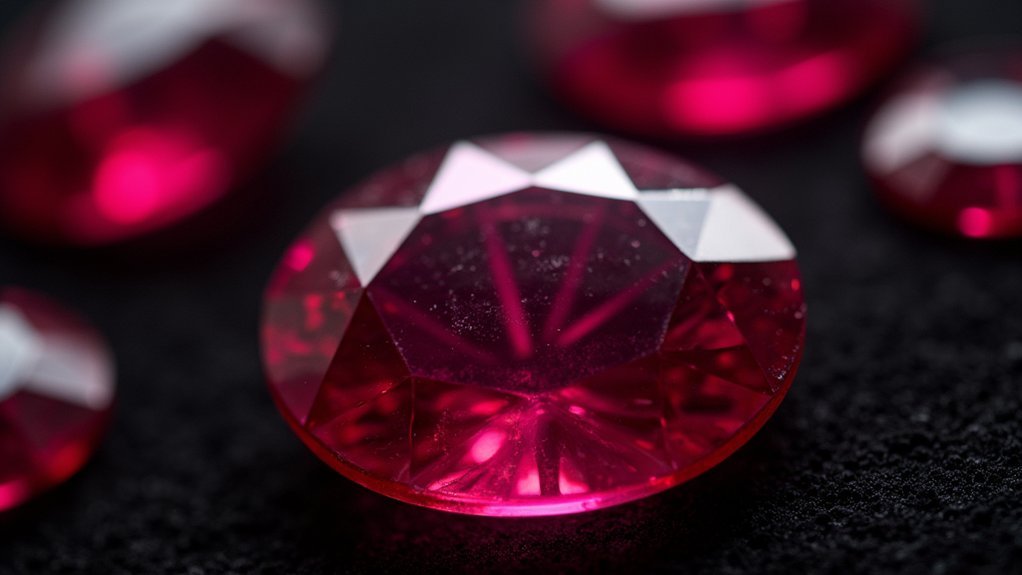
Inclusions serve as nature’s fingerprints within every ruby, telling stories of their formation and authenticity. As a gem expert, you’ll need to recognize how these internal features affect grading and certification.
Certified gemstones with documentation of their inclusions provide transparency about quality and treatments the stone may have undergone.
When examining rubies, consider:
- Types of inclusions – Rutile needles often indicate natural origin, while certain crystal patterns may suggest treatments.
- Distribution patterns – How inclusions are arranged affects overall clarity and value.
- Visibility factors – Less noticeable inclusions result in higher grades and increased market prices.
Your ability to interpret these characteristics will determine how accurately you can assess authenticity and value in the competitive ruby market.
How Certification Affects Ruby Market Valuation
Beyond understanding internal features, gem experts must grasp how certification transforms a ruby’s market position. Ruby certification establishes critical valuation factors through standardized assessment of color, clarity, cut, and carat weight. You’ll find that certified rubies command premium prices, particularly when untreated or from prestigious origins.
| Valuation Factor | Impact | Price Differential |
|---|---|---|
| Treatment Status | Higher value for untreated | 20-30% premium |
| Geographic Origin | Burmese origin premium | 50-100% higher |
| Certification | Enhanced resale value | Significant advantage |
Market valuation becomes more transparent with certification, allowing you to make data-driven pricing decisions. As gem experts know, certification doesn’t just document a stone’s characteristics—it fundamentally alters its market trajectory by providing the verification that sophisticated buyers demand.
Technological Advancements in Ruby Testing Procedures
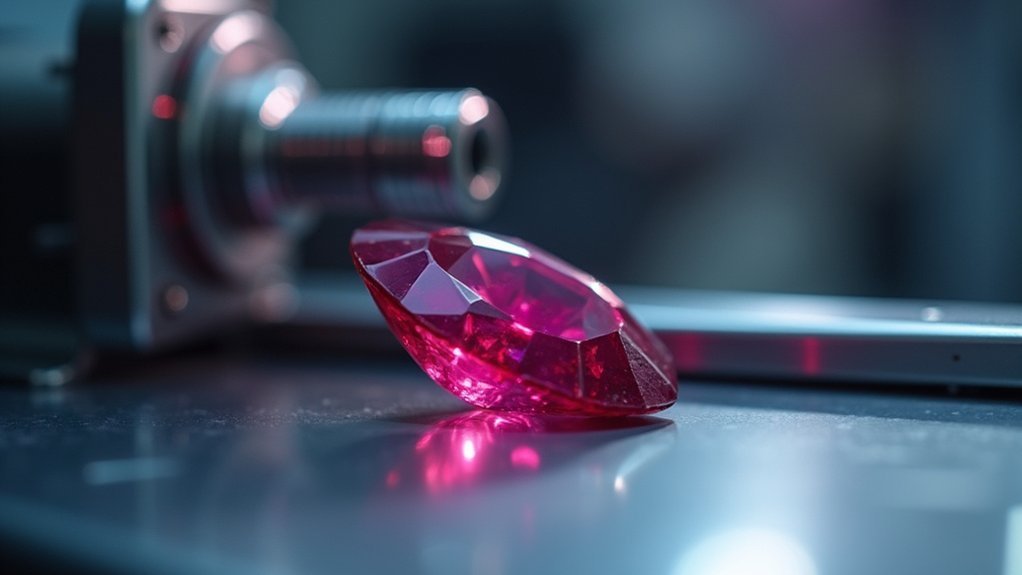
While traditional methods once dominated ruby assessment, technological breakthroughs have revolutionized how you’ll experience the certification process today.
Modern gemological tools now deliver unprecedented accuracy in determining a gemstone’s authenticity. Spectroscopy and X-ray fluorescence techniques identify chemical compositions and trace elements, revealing both origin and treatments applied to each ruby.
- High-resolution photomicrography captures detailed images of inclusions and surface features, enhancing clarity assessment beyond what the naked eye can detect.
- Laser-induced breakdown spectroscopy offers non-destructive, rapid analysis of elemental makeup without compromising the ruby’s integrity.
- Advanced computer algorithms and AI integration compare your ruby against extensive databases, dramatically improving grading reliability and efficiency.
These innovations guarantee you’ll receive more accurate, objective certification that truly reflects your ruby’s value.
Ethical Sourcing Verification Through Certification
As you invest in precious rubies, certification serves as your guarantee that these gemstones meet rigorous ethical standards throughout their journey from mine to market.
When you purchase certified rubies, you’re accessing vital origin information that traces each stone back to its source, confirming compliance with established environmental standards.
Reputable certification laboratories require adherence to initiatives like the Kimberley Process, effectively preventing conflict stones from entering the marketplace.
This verification process combats trade associated with human rights abuses while promoting responsible mining practices worldwide.
Key Certification Bodies and Their Methodologies Compared
When selecting a ruby certification, you’ll encounter several respected authorities that employ distinct methodologies to evaluate these precious gemstones.
The GIA stands out with its advanced technology and strict 4Cs framework for thorough ruby evaluations, while IGI offers detailed reports with quick turnaround times, including critical treatment disclosures.
- The American Gem Society uses a unique grading scale emphasizing precise measurements and transparency, ensuring consistent ruby assessments.
- GIA’s gem certification process is considered the gold standard, focusing on scientific analysis and objective grading.
- IGI provides extensive documentation that specifically details treatments and enhancements, essential information when investing in fine rubies.
When choosing between certification bodies, consider their reputation and methodologies—GIA and IGI typically maintain the highest market integrity and consumer confidence.
Building Client Trust Through Certified Ruby Authentication
In today’s competitive gem market, establishing credibility hinges on your ability to authenticate the rubies you sell. When you provide certified gemstones, you’re offering more than beautiful pieces—you’re delivering documented proof of quality and authenticity.
Your clients seek trustworthy professionals who can verify what they’re purchasing. Detailed certification reports from recognized labs like GIA or IGI transparently communicate your ruby’s color, clarity, and treatment status, eliminating uncertainty. This authentication process demonstrates your commitment to honesty and precision.
Certification transforms a beautiful stone into an investment-grade purchase with documented provenance and quality assurances.
Certified rubies command premium prices because buyers know they’re getting exactly what’s described. By prioritizing certification, you’ll build lasting client relationships based on confidence rather than promises.
The peace of mind you provide through professional authentication transforms first-time buyers into loyal, returning customers who value your expertise.
Frequently Asked Questions
What Is the Most Trusted Gem Certification?
You’ll find the GIA (Gemological Institute of America) is the most trusted gem certification authority. Their rigorous standards, advanced testing technologies, and consistent grading practices guarantee your gemstone’s authenticity and quality.
Who Certifies Ruby?
Reputable gemological laboratories like GIA, IGI, and AGS certify your rubies. They’ll examine your stone’s characteristics using advanced technology, verify its authenticity, identify treatments, and determine its origin to guarantee you’re getting accurate information.
What Is Gemstone Certification?
Gemstone certification is a formal document you’ll receive from independent labs that verifies your gem’s authenticity and quality. It includes details about the stone’s characteristics, treatments, and a unique identification number for verification.
In Summary
As you’ve seen, proper ruby certification isn’t just paperwork—it’s your credibility foundation in the gem market. When you’re equipped with certification expertise, you’ll confidently distinguish natural stones from synthetics, identify treatments, and verify ethical sourcing. Your clients will trust your assessments when backed by recognized certification bodies. In today’s competitive marketplace, your certification knowledge directly translates to professional success and industry respect.

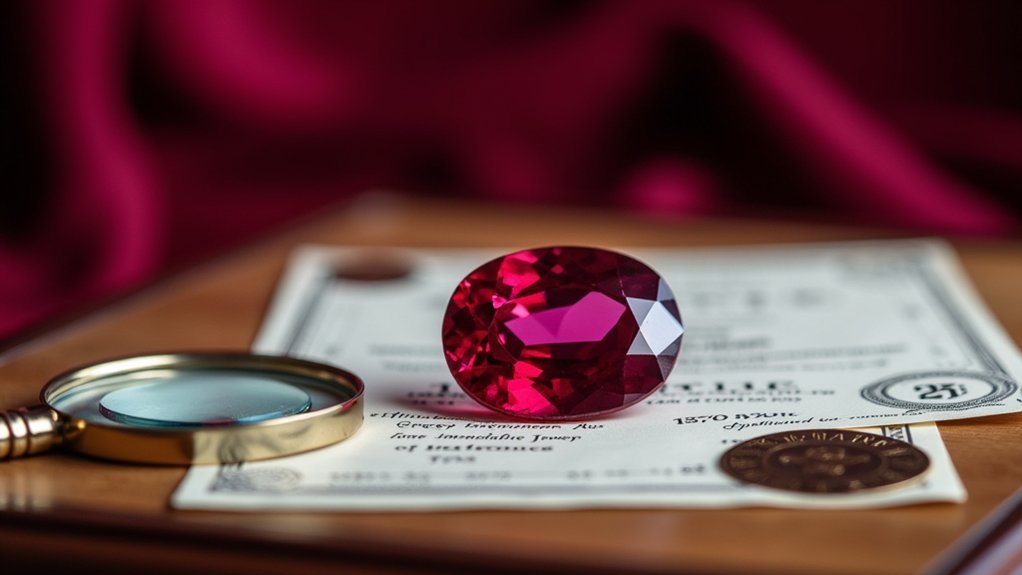
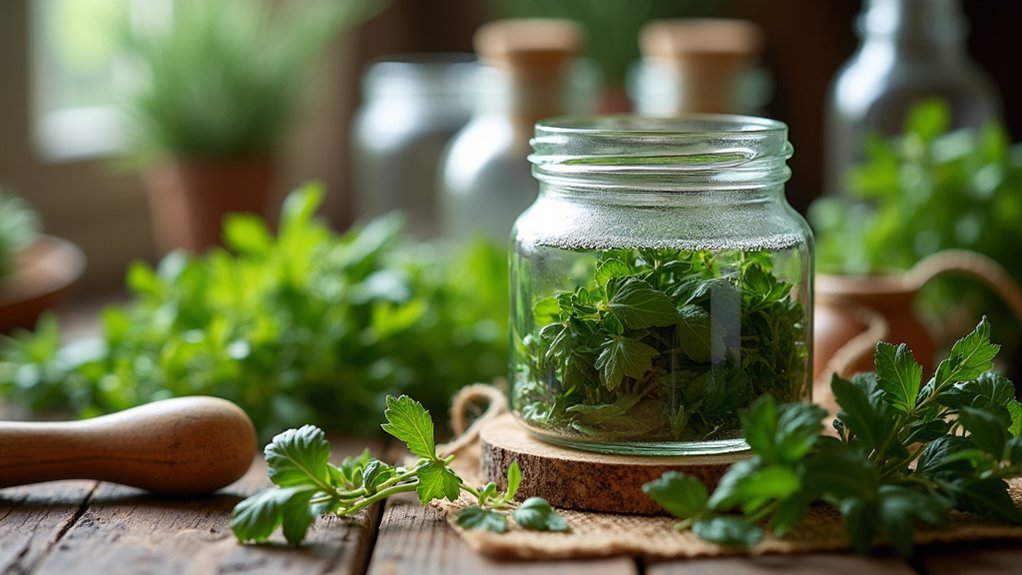
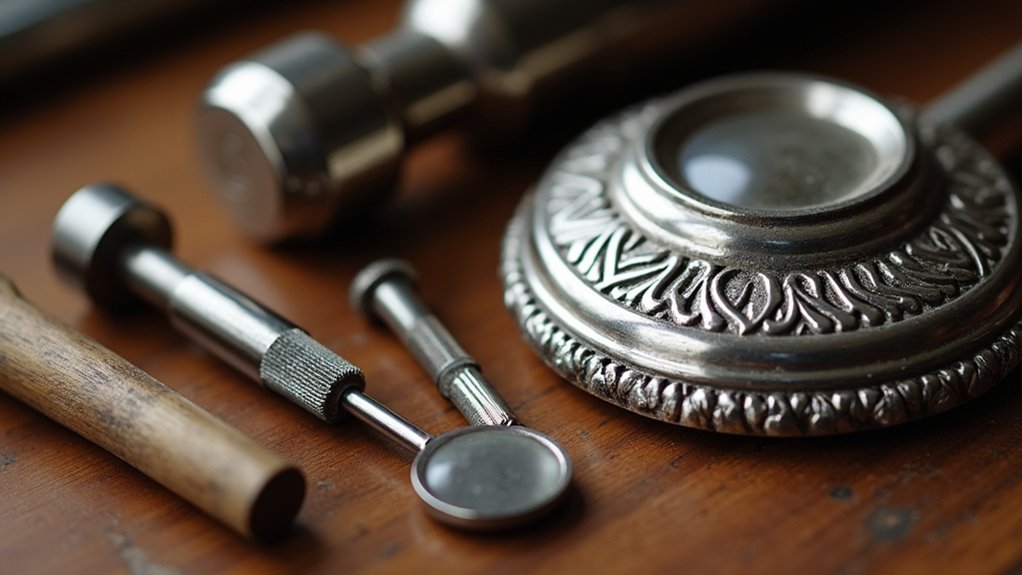
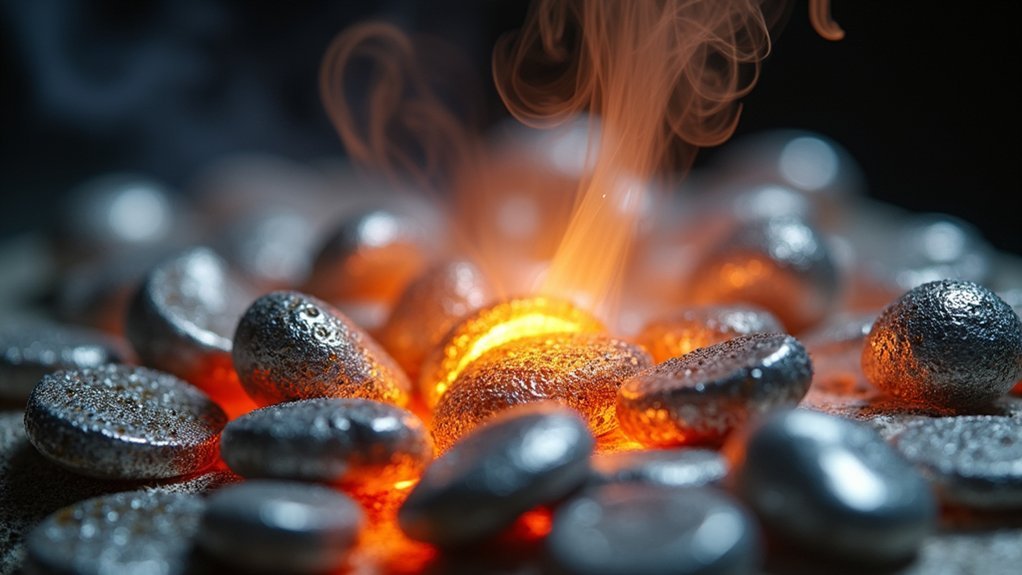
Leave a Reply